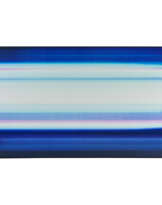ID 854624
Lot 2162 | Wesely, Michael
Geb. 1963 München, lebt und arbeitet in Berlin.
«Der Orinoco am Camp Orinoquia spätnachmittags».
C-Print auf Alu-Dibond unter Plexiglas (Diasec). U.l. typographisch einbelichtet sign., 1999 dat., bet. und 1/3 num.
H. 100, B. 150 cm (Alu-Dibond). Künstler-Stahlrahmen.
Werk aus einer Auflage von drei Exemplaren.
Der Münchner Photograph hat zu Ehren des 200. Jahrestages von Alexander von Humboldts Mittel- und Südamerika-Expedition (1799 - 1804) großformatige Photographien des zweitgrößten Flusses Südamerikas, dem Orinoco, geschaffen. Wesely verwendet hier eigens gebaute Kameras mit spaltförmigen Öffnungen statt einer runden Linse. «Mit der Konsequenz, dass sich die einfallenden Lichtstrahlen nicht mehr gleichmäßig ausbreiten können, wie es bei einer runden Öffnung der Fall wäre, sondern sich so zu überlagern beginnen, dass nur noch Lichtstreifen vom Film aufgezeichnet werden. […] Die Bilder verweigern sich komplett der Lesbarkeit. […] Zwangsläufig verlagert sich unsere Wahrnehmung auf die rein ästhetischen Qualitäten: Wir beginnen also die Bilder zu betrachten, als handele es sich bei Ihnen um abstrakte Malerei.» (Martina Fuchs, Zur Sichtbarmachung des Unsichtbaren, in: Clemens Fahnemann (Hrsg.), Michael Wesely, Photographien, Photographs, Berlin 2001, S. 13 - 14.).
Provenienz: Privatsammlung Freiburg i.Br.
Zustandsbericht:
Sehr guter Gesamteindruck. Rahmen mit kaum merklichen Handhabungsspuren.
| Artist: | Michael Wesely (1963) |
|---|---|
| Auction house category: | Modern and Contemporary art |
| Artist: | Michael Wesely (1963) |
|---|---|
| Auction house category: | Modern and Contemporary art |
| Address of auction |
Auktionshaus Kaupp GmbH Schloss Sulzburg, Hauptstr. 62 79295 Sulzburg Germany | ||||||||||||||
|---|---|---|---|---|---|---|---|---|---|---|---|---|---|---|---|
| Preview |
| ||||||||||||||
| Phone | +49763450380 | ||||||||||||||
| Fax | +49 7634 5038 50 | ||||||||||||||
| Buyer Premium | 33.32 % | ||||||||||||||
| Conditions of purchase | Conditions of purchase | ||||||||||||||
| Shipping |
Postal service Courier service pickup by yourself | ||||||||||||||
| Payment methods |
Wire Transfer | ||||||||||||||
| Business hours | Business hours
|












